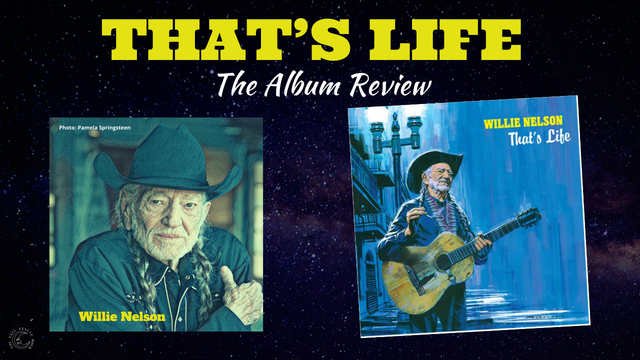The Recording Academy announced Willie Nelson received a Grammy nomination for “Best Traditional Pop Vocal Album” for his 2021 record “That’s Life.” As someone who has listened to this album since it came out, my fascination has been enduring.
Willie Nelson records Sinatra songs
While Willie Nelson is one of the most essential songwriting contributors in the canon of American popular song, he’s also one of just a few songwriters who expertly interprets the songs others wrote, including so many classics of the Great American Songbook. The songs Willie sang on “That’s Life” have been around a while and were all made famous by Frank Sinatra. The Grammys categorize them as “traditional pop,” but whatever label you use, the songs of Sinatra will endure forever.
Nelson is one of the most prolific recording artists
Make no mistake, the body of work Frank Sinatra left behind is nothing short of extraordinary. There are only a couple of American singers around who released that number of studio albums. At the top of the list in terms of quantity are Tony Bennett and Willie Nelson. Sinatra expressed admiration for Willie Nelson after hearing one of Willie’s most iconic albums, “Stardust,” which was his first foray into the American standards. It’s no question that Sinatra is a big influence on Nelson’s singing. He once remarked that his favorite singer “is and always will be, Frank Sinatra.”
Nelson has recorded many standards albums
Ask anyone to start listing country singers and it’s not surprising that the first name on most people’s list is “Willie.” But, there’s really nobody who sings quite like him, is there? His voice lends itself to a variety of songs, and the American Songbook is something he clearly loves. He’s done a total of 9 albums entirely, or almost entirely, pop standards. Take a listen to any of these: “Stardust,”“Somewhere Over the Rainbow,” “Without a Song,” “Angel Eyes,” “American Classic,”“Let’s Face the Music and Dance,” “Summertime: Willie Nelson Sings Gerswhin” or“My Way.” With his ability to emote a lyric, in Willie’s hands these songs always manage to seem new and not at all dated.
“That’s Life” recorded at Capitol Studios
Willie Nelson’s studio album “That’s Life” is his 71st, produced by Buddy Cannon and Matt Rollings. The album was primarily recorded at the famed Capitol Studios, a studio well-known for the records Frank Sinatra made there. “That’s Life” was mixed by legendary engineer Al Schmitt, who worked with Frank Sinatra on the duets albums. Sadly, it would be one of the last projects in the late Al Schmitt’s unprecedented career in the recording business. Willie’s first salute to Sinatra entitled “My Way,” came out in 2018 and won a Grammy. Unlike “My Way,” this second volume features strings, and even more interesting selections.
“That’s Life” has a theme
Francis Albert Sinatra recorded at least 1,200 songs. With such an abundance of songs to choose from, Nelson picked songs that reflect the highs and lows of our time. The songs all seem to fit the theme of life’s many positions: “up and down, over and out.”
As is always the case with Willie Nelson, the singing on this album is full of emotion. There’s a smile in Willie’s voice when he sings the title track, “That’s Life.” It felt like a wise reminder that no matter how good or bad it seems, it’s a part of the game.
So often we say “this too shall pass” when we’re experiencing the worst of things, but we don’t like to remember it applies to the good times too. The human experience is to be deeply in touch with both the jubilation of “riding high” and the sorrow of being “shot down.”
“That’s Life” recorded by many singers
“That’s Life” has been recorded by a diversity of singers, from Frank Sinatra to David Lee Roth. The co-writer Dean Kay talked to Jenna Anderson of Toluca Lake magazine about it’s enduring appeal. “The song is doing much better today than when it was a hit.” How fascinating that almost 60 years later it’s being recorded by Willie Nelson. “It just goes out and finds ways to get itself in trouble all the time, and it works over and over again,” Kay commented.
Willie Nelson sings some of my favorite Sinatra songs on this release: “Nice Work if You Can Get It” is the opening track. “In the Wee Small Hours of the Morning” is exceptional and the duet with jazz great Diana Krall on “I Won’t Dance” is lively and a welcome contrast.
Cottage for Sale
An especially remarkable track is the standard “Cottage for Sale,” where Willie really lives the lyrics. I recall master lyricist Marty Panzer analyzing the song. He called it “a four-hour movie in a three minute song.” He went on to say “every word has significance, and is appropriate, it’s conversational, it’s descriptive, it paints a picture.”
Album closes with gems
I especially love the pair of gems at the end of the album. The second to the last track, “Learnin’ the Blues,” suits Willie and the band perfectly. Is that vibraphone? I love it. Interesting side note, when Frank Sinatra’s version was out, it was the most frequently played song on the radio.
The record ends with “Lonesome Road.” It’s poetic and very different from how Sinatra approached the song. It has a gospel feel in Willie’s hands. There’s even the faint sound of handclaps. You could almost imagine it being performed in church.
“That’s Life” is lively and true
If an album could ever be described as lively and true, it’s Willie Nelson’s “That’s Life.” It’s bluesy, dreamy and just a tad nostalgic. It keeps pulling you back in. Whether I’m listening casually or more intently with headphones on, there’s always something new to notice.
As Willie Nelson said to Beville Darden, “If a song was ever good, it’s still good.” There are few singers who can make classic material like the songs on “That’s Life” sound so contemporary, but he is, after all Willie Nelson.


